Networks tutorial: Difference between revisions
No edit summary |
|||
| (66 intermediate revisions by 2 users not shown) | |||
| Line 1: | Line 1: | ||
{{tutorial prerequisites | {{tutorial prerequisites | ||
|tutorial=This tutorial relies on base knowledge about the editor interface. | |tutorial=This tutorial relies on base knowledge about the editor interface. | ||
|project=This tutorial can be followed with any project of any arbitrary location. Recommended is to create or load a project in the editor with an urban residential area with multiple neighborhoods. | |project=This tutorial can be followed with any project of any arbitrary location. Recommended is to create or load a project in the editor with an urban residential area with multiple neighborhoods. | ||
|required-excel= | |required-excel= | ||
|additional= | |additional= | ||
|Start your project. This can be a pre-existing project, or a newly created project. | |Start your project. This can be a pre-existing project, or a newly created project. | ||
}} | }} | ||
==Introduction to networks== | ==Introduction to networks== | ||
Networks are a separate data layer in a | Networks are a separate data layer in a [[project]], intended to model actual resource transport networks, such as for gas, heat, and internet. They are modeled as a mathematical graph consisting of vertices (points) and edges (lines connecting the points). | ||
Networks are composed of a number of datatypes: | Networks are composed of a number of datatypes: | ||
* Net | * [[Net Node]]s: These form the vertices of the network graph; the individual points which can be connected by lines. Net nodes cannot be directly edited as a discrete datatype as such, but are a relevant datatype to be aware of when working with networks. | ||
* Net | * [[Net Line]]s: These form the edges of the network; the connections between the points. Net lines are defined by the net nodes they connect, and form the connections between one point on the network and another. | ||
* Net | * [[Net Load]]s: These form a collection of properties for end-points on the network, and must be connected to any net node which forms an end-point on the network. This means that any net node which has only 1 net line connecting to it should have a net load connected to it. The net load defines the amount of the specified resource the endpoint produces or consumes. | ||
These datatypes form the actual network. However, when discussing networks in the {{software}}, the following datatypes are of importance when dealing with networks: | These datatypes form the actual network. However, when discussing networks in the {{software}}, the following datatypes are of importance when dealing with networks: | ||
* Net | * [[Net Function]]s: Just like [[building]]s being defined by a function definition, net lines have a net function definition as well. Any values not defined specifically for an individual net line, are derived from the net function definition. | ||
* Net | * [[Net Cluster]]s: Net loads can be grouped together into clusters, to make interacting with the net loads more manageable for end users. Clusters are not directly part of the network but serve as an interface between the network and end-user, for example by visualizing them as [[popup]]s in the [[3D Visualization]]. | ||
{{page_break}} | |||
==Creating a simple network== | ==Creating a simple network== | ||
| Line 28: | Line 27: | ||
[[File:network-configuration-dropdown.jpg|350px|frame|center|The location of the network configurations.]] | [[File:network-configuration-dropdown.jpg|350px|frame|center|The location of the network configurations.]] | ||
First, activate the electrical network. Select the "Electricity" net type | First, activate the electrical network. Select the "Electricity" net type. | ||
[[File:network-left-electricity.jpg|350px|frame|center|Select the currently inactive electricity network.]] | [[File:network-left-electricity.jpg|350px|frame|center|Select the currently inactive electricity network.]] | ||
{{page_break}} | |||
Make sure it's activated in the right panel, by checking the "Active" checkbox. | |||
[[File:network-right-electricity-active.jpg|350px|frame|center|Set the network to be active.]] | [[File:network-right-electricity-active.jpg|350px|frame|center|Set the network to be active.]] | ||
{{page_break}} | |||
===Drawing networks=== | |||
Next, we can draw the network. | Next, we can draw the network. | ||
{{editor location|net edit}} | {{editor location|net edit}} | ||
[[File:network-bottom-edit-add.jpg|350px|frame|center|The network editing options in the bottom panel.]] | [[File:network-bottom-edit-add.jpg|350px|frame|center|The network editing options in the bottom panel.]] | ||
Click in a location in the 3D | Click in a location in the [[3D Visualization]] to set the first net node location. Click in another location to set the second net node location. You will see a net line appear in the 3D Visualization. | ||
[[File:network-draw1.jpg|350px|frame|center|The first drawn net line.]] | [[File:network-draw1.jpg|350px|frame|center|The first drawn net line.]] | ||
{{page_break}} | |||
As you move the cursor, you will see a predicted line in bright yellow, which indicates where the next line will be placed when you click again. | As you move the cursor, you will see a predicted line in bright yellow, which indicates where the next line will be placed when you click again. | ||
| Line 43: | Line 48: | ||
Make the network circle back on itself, letting the last net line connect to one of the intermediate nodes. | Make the network circle back on itself, letting the last net line connect to one of the intermediate nodes. | ||
[[File:network-draw3.jpg|350px|frame|center|A relatively simple network.]] | [[File:network-draw3.jpg|350px|frame|center|A relatively simple network.]] | ||
If at any point during this proces you place a net line where you don't want one, select the "remove" option in the bottom panel. You can then click on the net line you misplaced to remove it. Then, you can switch the setting back to "Add" to resume drawing new net lines. | |||
Click on the "Add" radio button in the bottom panel to "unfocus" the cursor from the current drawing action. Then click on any node to focus the drawing action there, and create a small offshoot from the network. Repeat this process a few times so the network has a couple of endpoints. | Click on the "Add" radio button in the bottom panel to "unfocus" the cursor from the current drawing action. Then click on any node to focus the drawing action there, and create a small offshoot from the network. Repeat this process a few times so the network has a couple of endpoints. | ||
[[File:network-draw4.jpg|350px|frame|center|A relatively simple network with a few offshoots.]] | [[File:network-draw4.jpg|350px|frame|center|A relatively simple network with a few offshoots.]] | ||
{{page_break}} | |||
===Adding net loads=== | |||
This series of net lines together form a very simple network. However, right now the network is just a collection of lines between points. The next step is to add net loads, the set of definitions which indicate what happens at a given endpoint. | This series of net lines together form a very simple network. However, right now the network is just a collection of lines between points. The next step is to add net loads, the set of definitions which indicate what happens at a given endpoint. | ||
| Line 54: | Line 63: | ||
Add a net load to the project. | Add a net load to the project. | ||
[[File:network-left-net load-add.jpg|350px|frame|center|Add a net load.]] | [[File:network-left-net load-add.jpg|350px|frame|center|Add a net load.]] | ||
{{page_break}} | |||
The net load will be grouped in the "Unclustered" category, and then the "Electricity" network category. Select it. | The net load will be grouped in the "Unclustered" category, and then the "Electricity" network category. Select it. | ||
| Line 62: | Line 72: | ||
First, we connect the node to an endpoint. Select "Select Node" at the bottom of the right panel. | First, we connect the node to an endpoint. Select "Select Node" at the bottom of the right panel. | ||
[[File:network-right-net load-set.jpg|350px|frame|center|The options to relate the net load to net nodes, and to geographical locations.]] | [[File:network-right-net load-set.jpg|350px|frame|center|The options to relate the net load to net nodes, and to geographical locations.]] | ||
{{page_break}} | |||
Next, click on the first endpoint of the network. You will see the load is placed on the exact same location of the net node you clicked on. | Next, click on the first endpoint of the network. You will see the load is placed on the exact same location of the net node you clicked on. | ||
| Line 72: | Line 83: | ||
Notice that the network itself is unaltered. The net lines as we have drawn them are still the same. | Notice that the network itself is unaltered. The net lines as we have drawn them are still the same. | ||
{{page_break}} | |||
Now that the net load has been associated with the network, attributes must be added to it to define its effect on the flow of the network. Switch the right panel to the "attributes" tab, and add a "FLOW" attribute with a value of 1000. | Now that the net load has been associated with the network, attributes must be added to it to define its effect on the flow of the network. Switch the right panel to the "attributes" tab, and add a "FLOW" attribute with a value of 1000. | ||
[[File:network-right-net load-flow-producer.jpg|350px|frame|center|Add a "FLOW" attribute to the net load.]] | |||
This net load now defines the connected net node to be a point of resource production. In terms of an electricity network, this would for example be a power station. | |||
Add 2 more net loads to the project. Give them a "FLOW" attribute of -100, and connect them to different end-points on the network. | |||
[[File:network-draw5.jpg|350px|frame|center|The leftmost net load is a "producer". The other net loads are "consumers".]] | |||
Because the net loads have a negative "FLOW" attribute, their associated net nodes are points of resource consumption. In terms of an electricity network, this would for example be a house, or a factory. | |||
For our initial inspection of the network, it will also be desirable to set the timestate of all net loads to "READY". The timestate predicates whether the net load is actually "active" on the network. In other words, it sets a net load to be connected or disconnected to the network, and thus whether to take their "FLOW" into account during calculations. "NOTHING" means the net load is disconnected. "READY" means the net load is connected and active. | |||
{{page_break}} | |||
For each net load, change the timestate from "NOTHING" to "READY". | |||
[[File:network-right-net load-ready.jpg|350px|frame|center|The timestate setting dictates whether the net load is active or not.]] | |||
Lastly, we need to set a "root" for the network. This is a net load which serves as a sort of anchor for calculations. By convention, if a network only has a single producer it is usually set as root. | |||
Select the producer net load, and in the "General" tab make sure "Is Root" is checked. This sets this net load as the root of the network. | |||
[[File:network-right-net load-root.jpg|350px|frame|center|The "Is Root" setting anchors the network at this net load's net node.]] | |||
It will now also be listed in the left panel under the "Roots" category, rather than "Unclustered". | |||
{{page_break}} | |||
===Network calculations=== | |||
Now start a testrun. You may see parts of the network disappear. Specifically, the parts of the network which are not on the path between the consumers and the producer. | |||
[[File:network-draw6.jpg|350px|frame|center|The network appears to be only partially active during a testrun.]] | |||
{{editor location|net lines}} | |||
[[File:network-net lines-dropdown.jpg|350px|frame|center|Open the net lines menu.]] | |||
{{page_break}} | |||
Select a net line, and inspect the "FLOW" attribute. Repeat this for a number of net lines, and see that the net lines have varying "FLOW" attributes. | |||
[[File:network-right-net line-selected.jpg|350px|frame|center|Net lines now have a calculated flow.]] | |||
Stop the testrun, and see that the FLOW attribute disappears. | |||
This forms the basis of simple, manual network creation and configuration. | |||
{{page_break}} | |||
{{header|level=3|color=#c45911|Assignments}} | |||
These assignments guide you to further explore the basic calculation functionality already exposed with a basic network. | |||
# Increase the amount of electricity the consumers require, so that the sum of their consumption exceeds that of the producer. Inspect the net lines during a testrun to see the consequences. Increased consumption should lead to greater FLOW values in the net lines attached to them. Stop the testrun afterwards. | |||
# Add an additional line to the network branching off somewhere along the middle, which then branches off further into two endpoints. Add an additional consumer to one endpoint, and an additional producer to the other endpoint. Inspect the net lines during a testrun to see the consequences. The FLOW in the net lines should take into account where (additional) production is present. Stop the testrun afterwards. | |||
# Set the timestate of one or two net loads to "NOTHING". Inspect the net lines during a testrun to see the consequences. Stop the testrun afterwards. | |||
{{page_break}} | |||
==Network generation== | |||
Creating a network manually is only rarely the preferred situation, especially when dealing with larger project areas. For these situations, the {{software}} also offers a wizard to generate a complete network automatically. | |||
Open the network wizard. | |||
{{editor location|net wizard}} | |||
[[File:network-wizard-start.jpg|350px|frame|center|The network wizard will open in a separate window.]] | |||
''The wizard will guide you through the process, but during the generation process a number of questions will require your input. For any question posed without an explicit instruction listed here, simply use the default settings.'' | |||
One of the first questions posed is which network type to edit. Select the "ELECTRICITY" network, and opt for "Clear Network" (including the Root Load). This will delete the entire network as it had been created so far. | |||
[[File:network-wizard-network-clear.jpg|350px|frame|center|Clear the existing network.]] | |||
{{page_break}} | |||
Then opt to edit the network of the "ELECTRICITY" network type. | |||
[[File:network-wizard-network-edit.jpg|350px|frame|center|Opt to edit the network type.]] | |||
When prompted, opt to generate a (new) set of net loads. | |||
[[File:network-wizard-network-opt-generate.jpg|350px|frame|center|Choose to generate a new collection of net loads.]] | |||
When prompted, select a [[neighborhood]] in your project with residential buildings. | |||
[[File:network-wizard-network-neighborhoods.jpg|350px|frame|center|Select the residential projects in your neighborhood.]] | |||
{{page_break}} | |||
When prompted, select all [[stakeholder]]s. | |||
[[File:network-wizard-network-stakeholders.jpg|350px|frame|center|Select all stakeholders.]] | |||
By default, one of the selected options in the wizards is to simultaneously create the paths connecting all the net loads. This will automatically enable a number of additional wizard steps to perform this process. Make sure this options is still checked when continuing past the screen with this option. | |||
[[File:network-wizard-network-opt-line-generate.jpg|350px|frame|center|Make sure the "Create paths" option is checked.]] | |||
{{page_break}} | |||
When prompted, select the default Electricity line function. | |||
[[File:network-wizard-network-function.jpg|350px|frame|center|Select the default Electricity Line function.]] | |||
You will be prompted to place the initial root of the network somewhere in the project area. Opt to draw the root load in the map (and to switch to the [[3D Visualization]] to perform the action). | |||
[[File:network-wizard-network-opt-root.jpg|350px|frame|center|Opt to draw the root in the project, and then choose to go to the 3D Visualization to do so.]] | |||
Click in a location in the 3D Visualization to place the root load there. Preferably, place it near the edge of the residential neighborhood. | |||
[[File:network-wizard-network-root.jpg|350px|frame|center|The root placed in the project by clicking there in the 3D Visualization.]] | |||
{{page_break}} | |||
Finally, you will be prompted to initiate the actual process of generating the network. Click on "Generate" to begin this process. | |||
[[File:network-wizard-network-generate.jpg|350px|frame|center|Select "Generate" to begin the network generation process.]] | |||
After the generation process has completed, you will be able to finish this step of the wizard. | |||
[[File:network-wizard-network-finish.jpg|350px|frame|center|Finish the network generation step of the wizard.]] | |||
{{page_break}} | |||
The results pass through a validation step. If everything went well, it should report that the network is valid. However, it is possible that the generation algorithm has caused a few minor errors, such as a few loads placed in locations where the network cannot reach. In these cases, the next step in the wizard will propose a number of options to fix these issues. For the purpose of this tutorial, it is sufficient to opt to delete any erroneously unconnected sections, if present. | |||
[[File:network-wizard-network-validation.jpg|350px|frame|center|The wizard will validate that the generated network has no errors.]] | |||
This concludes the generation of the network itself. If you minimize (not close) the wizard window, you will be able to see the network in the [[3D Visualization]]. | |||
[[File:network-wizard-network-3D.jpg|350px|frame|center|Finish the network generation step of the wizard.]] | |||
{{page_break}} | |||
Next, the wizard can guide you through the generation of the associated clusters for the network. Opt to generate clusters. | |||
[[File:network-wizard-clusters-opt-generate.jpg|350px|frame|center|Opt to generate clusters for the network's net loads.]] | |||
When prompted, select all neighborhoods. The neighborhoods listed include only those with net loads. Notice that this might be more neighborhoods than when you generated the network, if any net loads have been placed on or near the edge of certain neighborhoods. | |||
[[File:network-wizard-clusters-neighborhoods.jpg|350px|frame|center|Select all neighborhoods. The listed neighborhoods are those with net loads.]] | |||
When prompted, select all [[stakeholder]]s. | |||
[[File:network-wizard-clusters-stakeholders.jpg|350px|frame|center|Select all stakeholders.]] | |||
{{page_break}} | |||
For the cluster method, take a moment to inspect the options available for cluster generation. However, the default option for cluster generation (generating clusters based on squares in the city map) is appropriate. | |||
[[File:network-wizard-clusters-options.jpg|350px|frame|center|The various cluster generation options.]] | |||
Finally, you will be prompted to initiate the actual process of generating the clusters. Click on "Generate" to begin this process. | |||
[[File:network-wizard-clusters-generate.jpg|350px|frame|center|Select "Generate" to begin the cluster generation process.]] | |||
-- | After the generation process has completed, you will be able to finish this step of the wizard. | ||
[[File:network-wizard-clusters-finish.jpg|350px|frame|center|Finish the cluster generation step of the wizard.]] | |||
{{page_break}} | |||
The results pass through a validation step. If everything went well, it should report that all loads in the network have been clustered. However, it is possible that the generation algorithm has caused a few minor errors, such as a few loads which have not been clustered. You will be informed that these net loads need to be removed from the project. In the editor interface, open the list of all net loads, and remove all net loads which are still categorized in the "unclustered" category. | |||
[[File:network-wizard-clusters-validation.jpg|350px|frame|center|The wizard will validate that the generated clusters provide full coverage of all net loads.]] | |||
Now that the clusters have been generated, the potentially hundreds or thousands of net loads in the project area have been grouped in at most a few dozen clusters. These collections of net loads allow a large number of net loads to be controlled en masse. The wizard will offer to generate a set of standardized [[interaction panel|panel]]s to allow this control. | |||
Opt to generate Template Excel [[Panel]]s. | |||
[[File:network-wizard-panels.jpg|350px|frame|center|Opt to generate panels to control the clusters.]] | |||
A new template panel will be created. This requires no further work to configure. | |||
{{page_break}} | |||
Continue through the remaining steps of the wizard and complete it. The wizard window will close and you will be returned to the 3D Visualization. | |||
[[File:network-wizard-finished.jpg|350px|frame|center|The wizard is now finished.]] | |||
Feel free to look around using the 3D Visualization and see how the network has been generated. | |||
Take note of the cluster symbols which have appeared. | |||
[[File:network-popup-clusters.jpg|350px|frame|center|Symbols in the 3D Visualization indicating the presence of clustered net loads.]] | |||
These mark the locations of clusters of net loads. They consist of one or more colored figures. The quantity indicates whether the cluster should be considered a clustering of individual connections, or a single connection serving multiple addresses. The color indicates which [[stakeholder]] owns the cluster. | |||
{{page_break}} | |||
Find a cluster, and switch to the stakeholder associated with the cluster. | |||
[[File:network-switch-stakeholder.jpg|350px|frame|center|Switch to a stakeholder who owns a cluster, such as a housing corporation.]] | |||
You will see a popup is available in this stakeholder's perspective, associated with the cluster. | |||
[[File:network-popup.jpg|350px|frame|center|The popup serves as a way to control the cluster.]] | |||
{{page_break}} | |||
Click on it to open the [[panel]] related to the cluster. | |||
[[File:network-popup-panel.jpg|350px|frame|center|The panel to control the cluster.]] | |||
It will display some basic information on the connections which are grouped together in this cluster. | |||
Close the panel for now. | |||
{{page_break}} | |||
===Interacting with a generated network=== | |||
Start a testrun. | |||
You will notice that the entire network has disappeared at the start of the testrun. This is because one of the default settings in the network wizard is to generate the network in the timestate "NOTHING", meaning all (consumer) net loads begin as disconnected. | |||
[[File:network-session.jpg|350px|frame|center|The net lines have disappeared.]] | |||
{{page_break}} | |||
Click on the popup again, and click on "Connect". This will fire a request to connect all the connections of the cluster to the network. | |||
[[File:network-session-connect.jpg|350px|frame|center|The net lines have reappeared.]] | |||
Notice that the net lines have now reappeared in the session, but only the net lines which lead to the connections which have been connected as part of the cluster. If you zoom out you can see more clearly that only some of the net lines have (re)appeared. | |||
Reopen the popup, and click on "Disconnect". This will undo the connections and return the network to an entirely disconnected state. | |||
{{page_break}} | |||
After this has completed, click on "Connect" again. The popup will indicate that a request to make these connections has been sent to the network owner (by default the municipality). | |||
[[File:network-session-request.jpg|350px|frame|center|The popup has changed, and another stakeholder must interact with the network.]] | |||
What parts of a network are or aren't connected are decided by all relevant stakeholders together. By default, the configuration provided for to approach this use-case allows for the first connection to be made unilaterally, but if any party has decided to undo that connection, the next time such a connection is to be made both parties must agree to it: both the owner of the connections and the owner of the network. | |||
If you switch your stakeholder to the network owner, you will notice that the network owner does not see a popup yet. This is because the network generation wizard does not automatically create a set of panels for the network owner. | |||
Stop the testrun, so that additional panels can be added. | |||
{{editor location|panels}} | |||
{{page_break}} | |||
In the list of panels, find the "Network Interaction" panel and select it. Take care to select the template panel, rather than one of the instances. | |||
[[File:network-panels-template.jpg|350px|frame|center|The popup has changed, and another stakeholder must interact with the network.]] | |||
Notice in the right panel that the options "Assign to stakeholder" and "use owner" are checked. This means that the panel is only single to a visible stakeholder, namely the owner of the cluster the panel is assigned to. | |||
[[File:network-panels-assigned-owner.jpg|350px|frame|center|The stakeholder configuration for the existing panel for network interaction.]] | |||
{{page_break}} | |||
At the bottom of the left panel (while the "Network Interaction" panel is still selected) select "Duplicate". This will create a new template panel based on the previous template panel. | |||
[[File:network-panels-template2.jpg|350px|frame|center|The stakeholder configuration for the existing panel for network interaction.]] | |||
In the right panel, uncheck the "Use owner" checkbox. Directly below, ensure the stakeholder dropdown is set to the stakeholder who's also the network owner. By default, the network owner is the municipality, so ensure that the dropdown is set to them. Lastly, activate the relational filter, and set its value to "NETOWNER". This will cause panels to be generated for that specific stakeholder, for each cluster of which they are the net owner. | |||
[[File:network-panels-assigned-netowner.jpg|350px|frame|center|The stakeholder configuration for the existing panel for network interaction.]] | |||
Note that for simple cases, a single stakeholder can be the net owner for all clusters in a network. However, in more complex setups it is possible to have multiple net owners. In these cases, additional panels should be created for each net owner. The configuration you just created will automatically generate their panels for all clusters under their jurisdiction. | |||
Select "Apply Template", and the necessary instances of this panel will be created. | |||
Note that no new popups have appeared in the 3D Visualization. For the net owner the popups are configured such that they will only appear when the net owner has a decision to make. The owner of the cluster still has to make the first connection before the popup will appear. | |||
Switch back to the stakeholder who owns the cluster, open the popup, and click on "Connect". Then wait for the testrun to start and the connections to be made. | |||
{{page_break}} | |||
Switch to the network owner. Now, the connected cluster does have a popup. This is because the network owner has the ability to reject connections. Open the popup, and you will see it contains the same information the owner of the cluster has. | |||
[[File:network-session-netowner-disconnect.jpg|350px|frame|center|The network owner can force the cluster to disconnect.]] | |||
Opt to disconnect the cluster. | |||
The net lines will disappear, because the connections will be undone, similar to when the owner of the cluster opts to disconnect. The cluster's popup for the network owner will disappear as well. The initiative to reconnect the cluster must come form the cluster owner. | |||
Close the panel, and switch to the stakeholder who owns the cluster. Opt to reconnect the cluster, and the popup and panel will indicate the network owner must approve of the connection. | |||
Switch to the network owner, and notice a popup is now visible, drawing attention as well. | |||
[[File:network-session-netowner-attention.jpg|350px|frame|center|The network owner's popup has appeared, and will draw attention if it's outside the current camera view.]] | |||
{{page_break}} | |||
Open the panel. It will have two explicit options to approve or deny the connection. | |||
[[File:network-session-netowner-decision.jpg|350px|frame|center|The network owner's popup contains options both to approve and deny the request.]] | |||
The network owner can decide, based on their own insights and dialog with the cluster's owner, whether to let the cluster be connected, or to revert it to a disconnected state. As long as the network owner does not explicitly allow the connection, the cluster will remain disconnected. | |||
Opt to deny the connection by clicking on 'Disconnect'. Notice the cluster remains disconnected, and the popup disappears again. | |||
As the cluster owner, opt to connect the cluster again. Now, as network owner, opt to approve the connection by clicking on 'Connect' in its popup. Notice the cluster is now connected. | |||
Stop the testrun, so all connections are removed again. | |||
{{page_break}} | |||
===Configure default interactions=== | |||
The default process for connecting and disconnecting clusters can be tweaked. | |||
Reopen the network wizard, and continue to the "Visualization" step. | |||
[[File:network-wizard-visualization.jpg|350px|frame|center|The options for configuring the approval process.]] | |||
There are two options available for tweaking the approval flow. | |||
* Netowner approval required: Whether the network owner needs to approve any connection before a connection is made. | |||
* Direct connect first request: If the network owner needs to approve connections, whether the first connection request is automatically approved. | |||
By default, both options are checked, meaning that the first connection is automatically approved, but all subsequent approval requests must be approved by the network owner. | |||
{{page_break}} | |||
{{header|level=3|color=#c45911|Assignments}} | |||
These assignments guide some experimentation with tweaking the approval flow of networks. | |||
# Disable the "Direct connect first request" setting, and start a testrun. Completely connect a cluster. Stop the testrun afterwards. | |||
# Disable the "Netowner approval required" setting, and start a testrun. Connect a cluster, and note at what point the network owner is able to prevent or counter the connection of the cluster. Stop the testrun afterwards. | |||
# In the first step of the network wizard, set the default connection status for the network to "READY". Start a testrun. Experiment with disconnecting and connecting a cluster. Stop the testrun afterwards. | |||
# Re-enable the "Direct connect first request" and "Netowner approval required" settings. Start a testrun. Experiment with disconnecting and connecting a cluster. Stop the testrun afterwards. | |||
{{Tutorial completed | |||
| learned=how to manually and automatically create networks in your project, and interact with the network using the default interaction options | |||
}} | |||
Latest revision as of 14:30, 30 January 2023
Prerequisites
The following prerequisites should be met before starting this tutorial:
- This tutorial relies on base knowledge about the editor interface. If you have not yet followed the tutorials related to those subjects please do so first.
- This tutorial can be followed with any project of any arbitrary location. Recommended is to create or load a project in the editor with an urban residential area with multiple neighborhoods.
Preparations
Take the following steps as preparation for following this tutorial:
- Start your project. This can be a pre-existing project, or a newly created project.
Introduction to networks
Networks are a separate data layer in a project, intended to model actual resource transport networks, such as for gas, heat, and internet. They are modeled as a mathematical graph consisting of vertices (points) and edges (lines connecting the points).
Networks are composed of a number of datatypes:
- Net Nodes: These form the vertices of the network graph; the individual points which can be connected by lines. Net nodes cannot be directly edited as a discrete datatype as such, but are a relevant datatype to be aware of when working with networks.
- Net Lines: These form the edges of the network; the connections between the points. Net lines are defined by the net nodes they connect, and form the connections between one point on the network and another.
- Net Loads: These form a collection of properties for end-points on the network, and must be connected to any net node which forms an end-point on the network. This means that any net node which has only 1 net line connecting to it should have a net load connected to it. The net load defines the amount of the specified resource the endpoint produces or consumes.
These datatypes form the actual network. However, when discussing networks in the Tygron Platform, the following datatypes are of importance when dealing with networks:
- Net Functions: Just like buildings being defined by a function definition, net lines have a net function definition as well. Any values not defined specifically for an individual net line, are derived from the net function definition.
- Net Clusters: Net loads can be grouped together into clusters, to make interacting with the net loads more manageable for end users. Clusters are not directly part of the network but serve as an interface between the network and end-user, for example by visualizing them as popups in the 3D Visualization.
Creating a simple network
A good way to learn how these items work in tandem is to create a small network in which each of these parts are represented.
Pick a location in your map with a little bit of space. You're going to create a small network in this location.
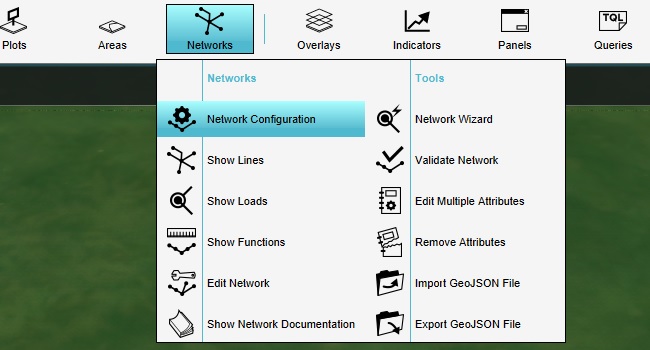
First, activate the electrical network. Select the "Electricity" net type.

Make sure it's activated in the right panel, by checking the "Active" checkbox.
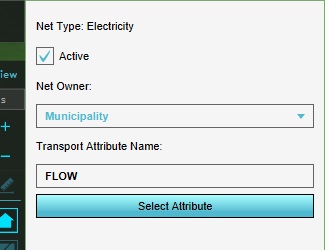
Drawing networks
Next, we can draw the network.
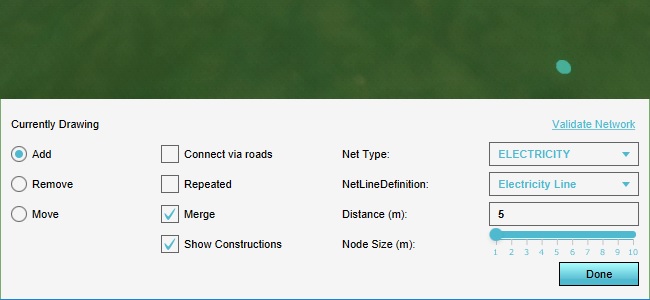
Click in a location in the 3D Visualization to set the first net node location. Click in another location to set the second net node location. You will see a net line appear in the 3D Visualization.
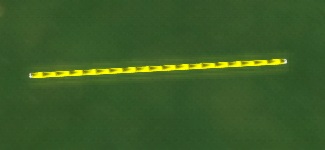
As you move the cursor, you will see a predicted line in bright yellow, which indicates where the next line will be placed when you click again.
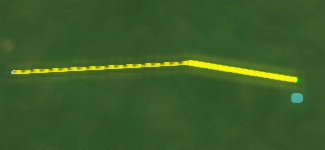
Make the network circle back on itself, letting the last net line connect to one of the intermediate nodes.

If at any point during this proces you place a net line where you don't want one, select the "remove" option in the bottom panel. You can then click on the net line you misplaced to remove it. Then, you can switch the setting back to "Add" to resume drawing new net lines.
Click on the "Add" radio button in the bottom panel to "unfocus" the cursor from the current drawing action. Then click on any node to focus the drawing action there, and create a small offshoot from the network. Repeat this process a few times so the network has a couple of endpoints.

Adding net loads
This series of net lines together form a very simple network. However, right now the network is just a collection of lines between points. The next step is to add net loads, the set of definitions which indicate what happens at a given endpoint.
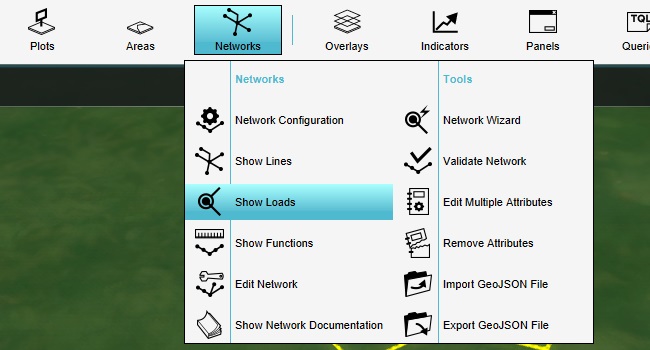
Add a net load to the project.

The net load will be grouped in the "Unclustered" category, and then the "Electricity" network category. Select it.
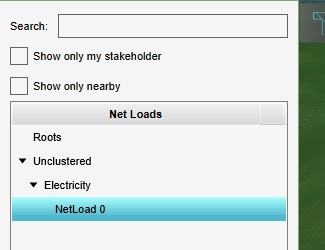
The net load has been created, but it must be connected to a valid endpoint on the network, and it must be given attributes which for the definition of what happens at that endpoint.
First, we connect the node to an endpoint. Select "Select Node" at the bottom of the right panel.
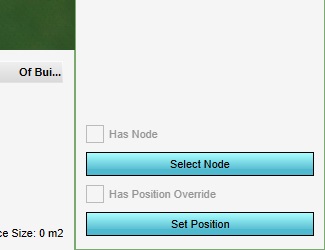
Next, click on the first endpoint of the network. You will see the load is placed on the exact same location of the net node you clicked on.
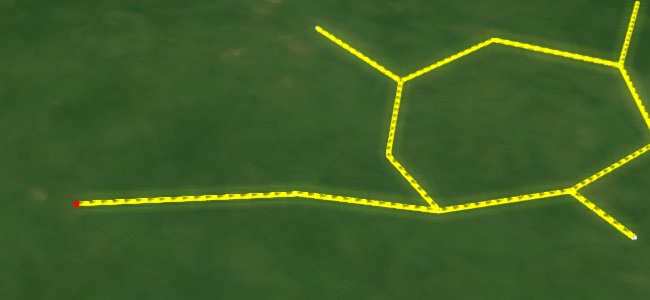
Often times, the indicative location of the net load is not identical to the exact location of the endpoint of the network. For this reason, it is also possible to set a location for the net load which is more representative of where the load for the network is really coming from. At the bottom of the right panel, select "Set Position".
Next, click near the endpoint where the net load is connected. You will see the net load appear in the location that you clicked. It will still indicate the net node it is connected to via a line.
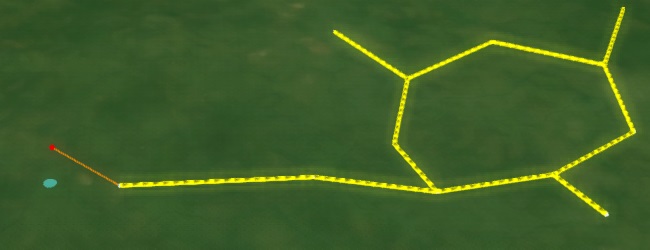
Notice that the network itself is unaltered. The net lines as we have drawn them are still the same.
Now that the net load has been associated with the network, attributes must be added to it to define its effect on the flow of the network. Switch the right panel to the "attributes" tab, and add a "FLOW" attribute with a value of 1000.
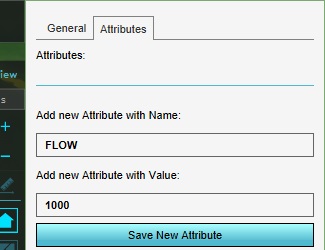
This net load now defines the connected net node to be a point of resource production. In terms of an electricity network, this would for example be a power station.
Add 2 more net loads to the project. Give them a "FLOW" attribute of -100, and connect them to different end-points on the network.

Because the net loads have a negative "FLOW" attribute, their associated net nodes are points of resource consumption. In terms of an electricity network, this would for example be a house, or a factory.
For our initial inspection of the network, it will also be desirable to set the timestate of all net loads to "READY". The timestate predicates whether the net load is actually "active" on the network. In other words, it sets a net load to be connected or disconnected to the network, and thus whether to take their "FLOW" into account during calculations. "NOTHING" means the net load is disconnected. "READY" means the net load is connected and active.
For each net load, change the timestate from "NOTHING" to "READY".
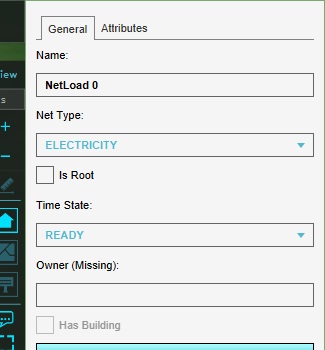
Lastly, we need to set a "root" for the network. This is a net load which serves as a sort of anchor for calculations. By convention, if a network only has a single producer it is usually set as root.
Select the producer net load, and in the "General" tab make sure "Is Root" is checked. This sets this net load as the root of the network.
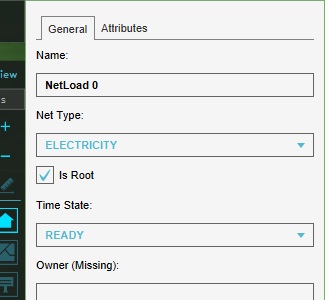
It will now also be listed in the left panel under the "Roots" category, rather than "Unclustered".
Network calculations
Now start a testrun. You may see parts of the network disappear. Specifically, the parts of the network which are not on the path between the consumers and the producer.
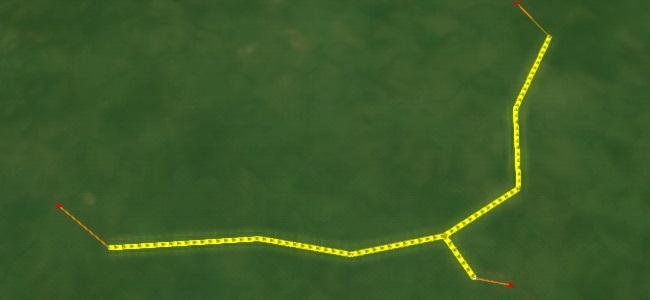
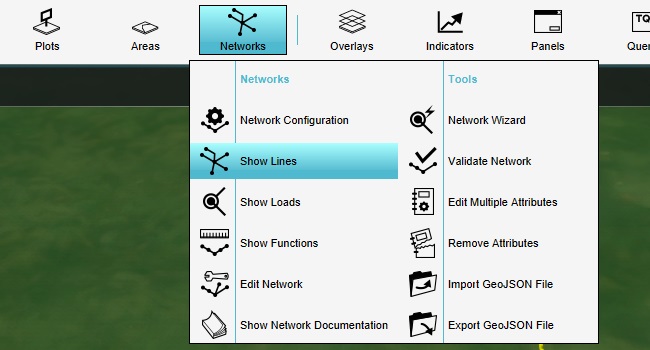
Select a net line, and inspect the "FLOW" attribute. Repeat this for a number of net lines, and see that the net lines have varying "FLOW" attributes.
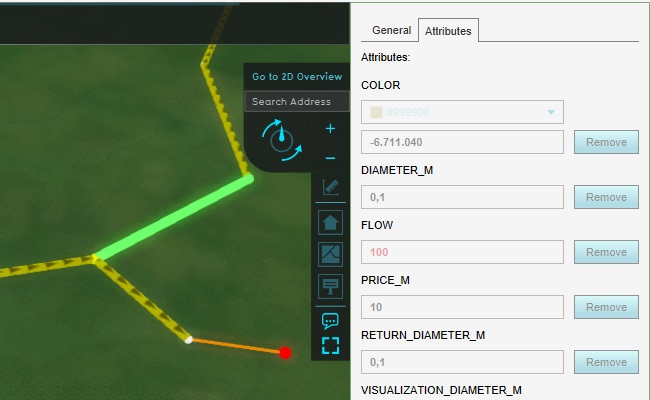
Stop the testrun, and see that the FLOW attribute disappears.
This forms the basis of simple, manual network creation and configuration.
Assignments
These assignments guide you to further explore the basic calculation functionality already exposed with a basic network.
- Increase the amount of electricity the consumers require, so that the sum of their consumption exceeds that of the producer. Inspect the net lines during a testrun to see the consequences. Increased consumption should lead to greater FLOW values in the net lines attached to them. Stop the testrun afterwards.
- Add an additional line to the network branching off somewhere along the middle, which then branches off further into two endpoints. Add an additional consumer to one endpoint, and an additional producer to the other endpoint. Inspect the net lines during a testrun to see the consequences. The FLOW in the net lines should take into account where (additional) production is present. Stop the testrun afterwards.
- Set the timestate of one or two net loads to "NOTHING". Inspect the net lines during a testrun to see the consequences. Stop the testrun afterwards.
Network generation
Creating a network manually is only rarely the preferred situation, especially when dealing with larger project areas. For these situations, the Tygron Platform also offers a wizard to generate a complete network automatically.
Open the network wizard.
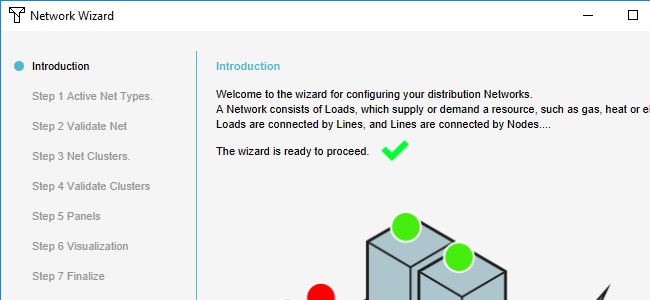
The wizard will guide you through the process, but during the generation process a number of questions will require your input. For any question posed without an explicit instruction listed here, simply use the default settings.
One of the first questions posed is which network type to edit. Select the "ELECTRICITY" network, and opt for "Clear Network" (including the Root Load). This will delete the entire network as it had been created so far.
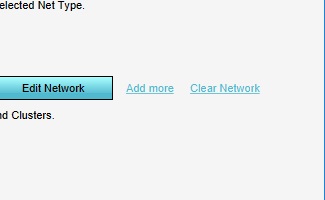
Then opt to edit the network of the "ELECTRICITY" network type.

When prompted, opt to generate a (new) set of net loads.

When prompted, select a neighborhood in your project with residential buildings.
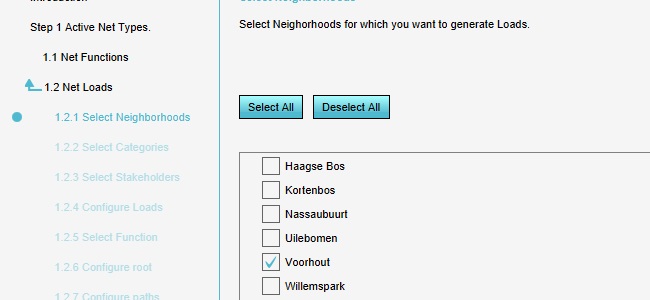
When prompted, select all stakeholders.
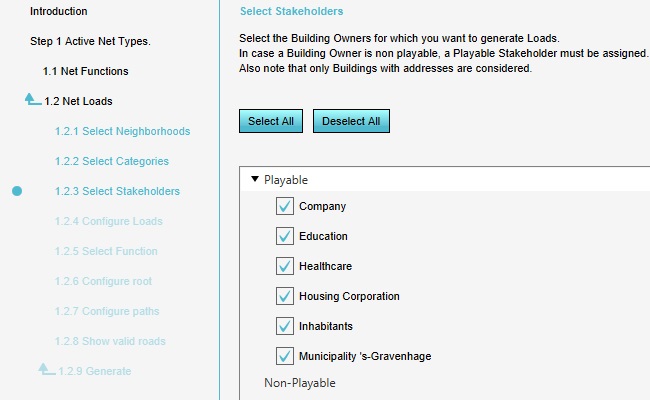
By default, one of the selected options in the wizards is to simultaneously create the paths connecting all the net loads. This will automatically enable a number of additional wizard steps to perform this process. Make sure this options is still checked when continuing past the screen with this option.

When prompted, select the default Electricity line function.
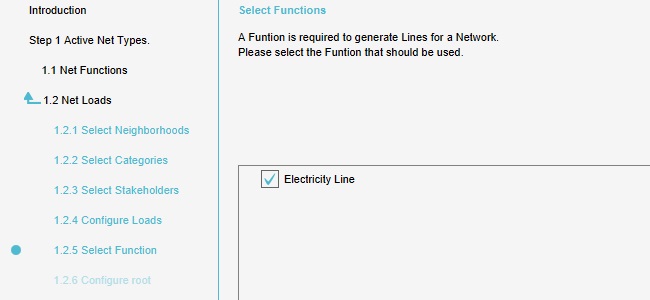
You will be prompted to place the initial root of the network somewhere in the project area. Opt to draw the root load in the map (and to switch to the 3D Visualization to perform the action).

Click in a location in the 3D Visualization to place the root load there. Preferably, place it near the edge of the residential neighborhood.
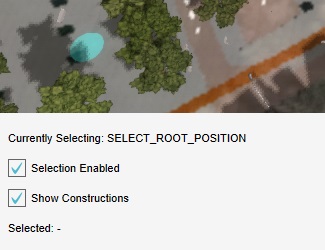
Finally, you will be prompted to initiate the actual process of generating the network. Click on "Generate" to begin this process.
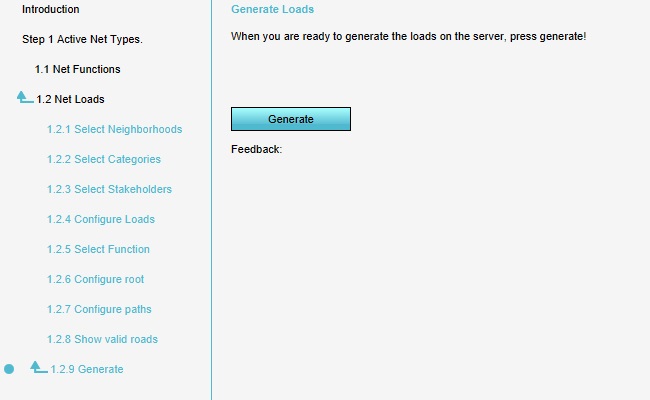
After the generation process has completed, you will be able to finish this step of the wizard.

The results pass through a validation step. If everything went well, it should report that the network is valid. However, it is possible that the generation algorithm has caused a few minor errors, such as a few loads placed in locations where the network cannot reach. In these cases, the next step in the wizard will propose a number of options to fix these issues. For the purpose of this tutorial, it is sufficient to opt to delete any erroneously unconnected sections, if present.

This concludes the generation of the network itself. If you minimize (not close) the wizard window, you will be able to see the network in the 3D Visualization.
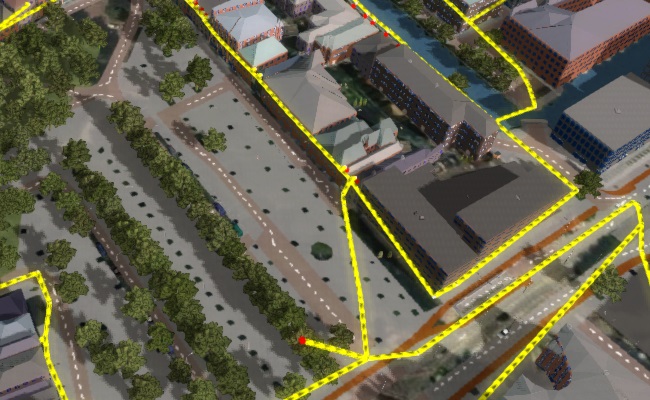
Next, the wizard can guide you through the generation of the associated clusters for the network. Opt to generate clusters.

When prompted, select all neighborhoods. The neighborhoods listed include only those with net loads. Notice that this might be more neighborhoods than when you generated the network, if any net loads have been placed on or near the edge of certain neighborhoods.

When prompted, select all stakeholders.

For the cluster method, take a moment to inspect the options available for cluster generation. However, the default option for cluster generation (generating clusters based on squares in the city map) is appropriate.
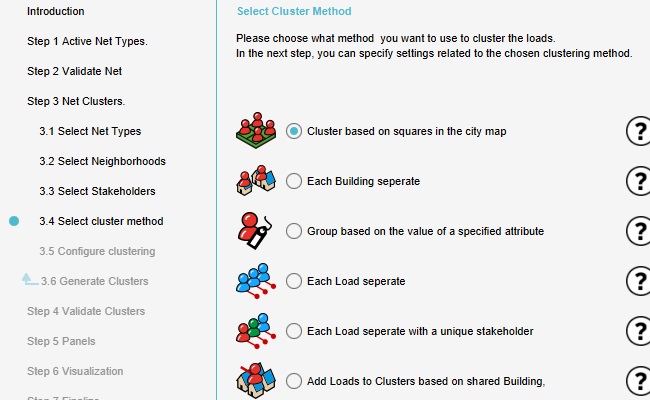
Finally, you will be prompted to initiate the actual process of generating the clusters. Click on "Generate" to begin this process.
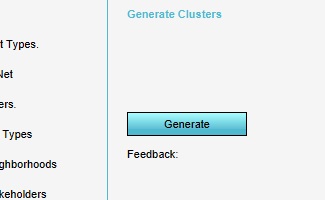
After the generation process has completed, you will be able to finish this step of the wizard.

The results pass through a validation step. If everything went well, it should report that all loads in the network have been clustered. However, it is possible that the generation algorithm has caused a few minor errors, such as a few loads which have not been clustered. You will be informed that these net loads need to be removed from the project. In the editor interface, open the list of all net loads, and remove all net loads which are still categorized in the "unclustered" category.
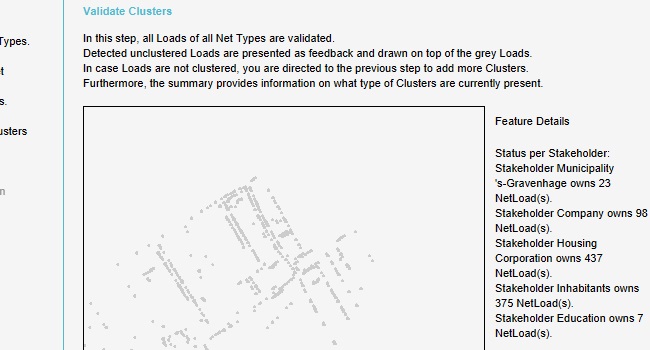
Now that the clusters have been generated, the potentially hundreds or thousands of net loads in the project area have been grouped in at most a few dozen clusters. These collections of net loads allow a large number of net loads to be controlled en masse. The wizard will offer to generate a set of standardized panels to allow this control.
Opt to generate Template Excel Panels.

A new template panel will be created. This requires no further work to configure.
Continue through the remaining steps of the wizard and complete it. The wizard window will close and you will be returned to the 3D Visualization.
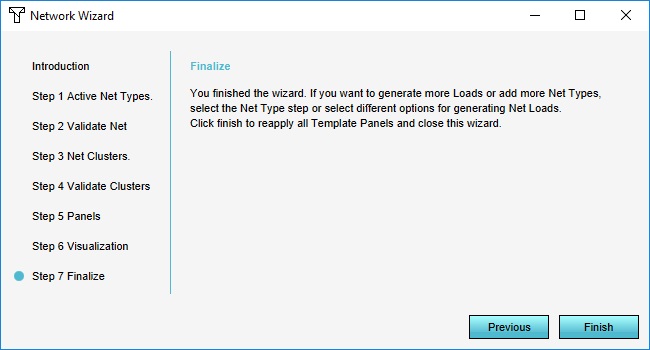
Feel free to look around using the 3D Visualization and see how the network has been generated.
Take note of the cluster symbols which have appeared.
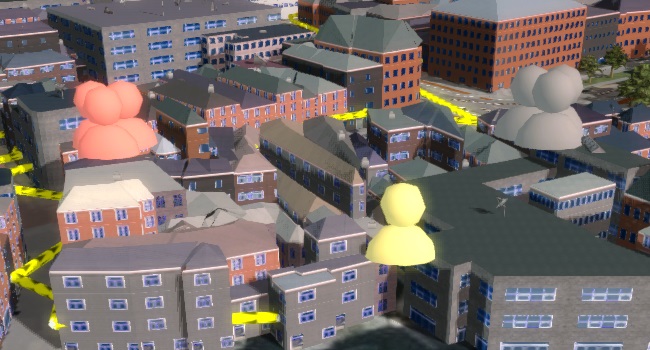
These mark the locations of clusters of net loads. They consist of one or more colored figures. The quantity indicates whether the cluster should be considered a clustering of individual connections, or a single connection serving multiple addresses. The color indicates which stakeholder owns the cluster.
Find a cluster, and switch to the stakeholder associated with the cluster.

You will see a popup is available in this stakeholder's perspective, associated with the cluster.

Click on it to open the panel related to the cluster.
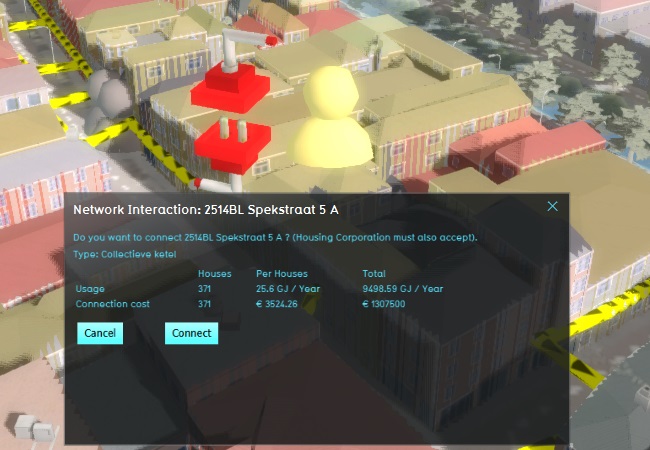
It will display some basic information on the connections which are grouped together in this cluster.
Close the panel for now.
Interacting with a generated network
Start a testrun.
You will notice that the entire network has disappeared at the start of the testrun. This is because one of the default settings in the network wizard is to generate the network in the timestate "NOTHING", meaning all (consumer) net loads begin as disconnected.
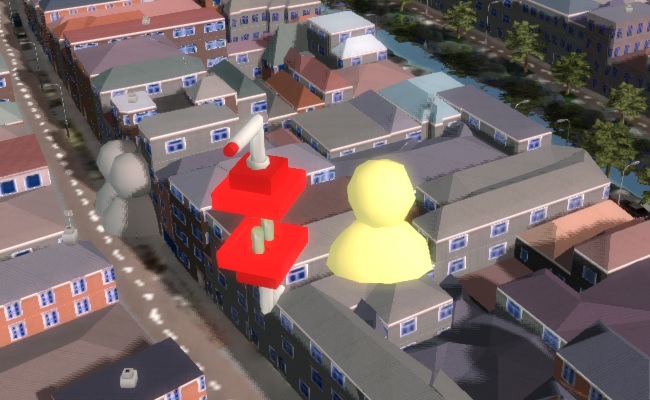
Click on the popup again, and click on "Connect". This will fire a request to connect all the connections of the cluster to the network.
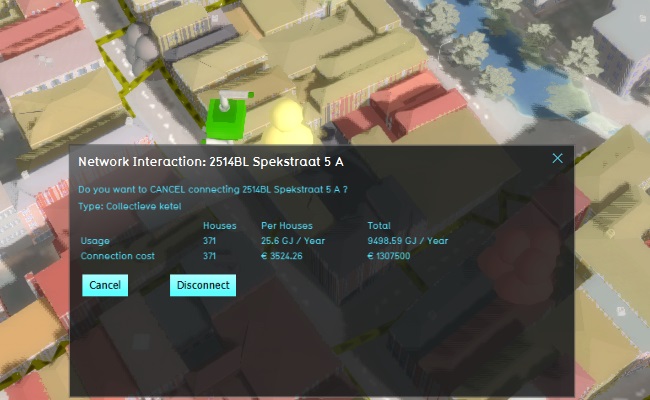
Notice that the net lines have now reappeared in the session, but only the net lines which lead to the connections which have been connected as part of the cluster. If you zoom out you can see more clearly that only some of the net lines have (re)appeared.
Reopen the popup, and click on "Disconnect". This will undo the connections and return the network to an entirely disconnected state.
After this has completed, click on "Connect" again. The popup will indicate that a request to make these connections has been sent to the network owner (by default the municipality).
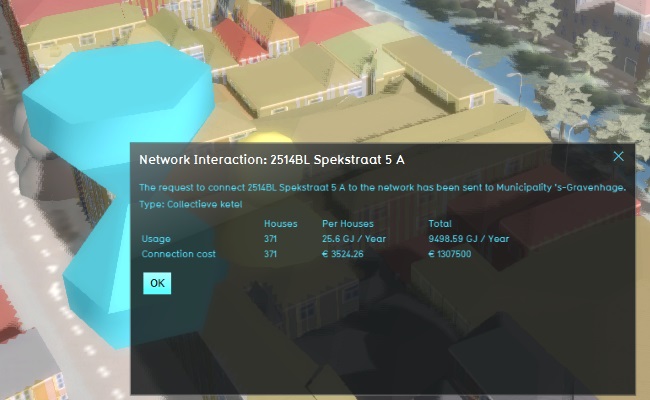
What parts of a network are or aren't connected are decided by all relevant stakeholders together. By default, the configuration provided for to approach this use-case allows for the first connection to be made unilaterally, but if any party has decided to undo that connection, the next time such a connection is to be made both parties must agree to it: both the owner of the connections and the owner of the network.
If you switch your stakeholder to the network owner, you will notice that the network owner does not see a popup yet. This is because the network generation wizard does not automatically create a set of panels for the network owner.
Stop the testrun, so that additional panels can be added.
In the list of panels, find the "Network Interaction" panel and select it. Take care to select the template panel, rather than one of the instances.
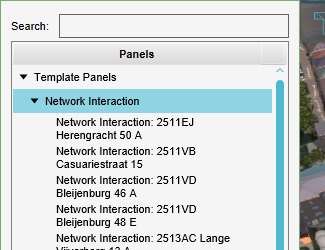
Notice in the right panel that the options "Assign to stakeholder" and "use owner" are checked. This means that the panel is only single to a visible stakeholder, namely the owner of the cluster the panel is assigned to.
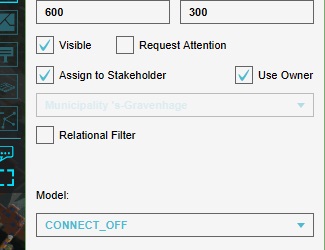
At the bottom of the left panel (while the "Network Interaction" panel is still selected) select "Duplicate". This will create a new template panel based on the previous template panel.
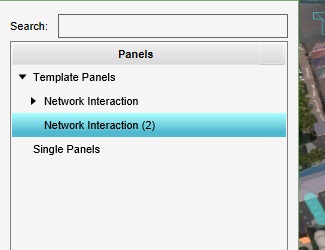
In the right panel, uncheck the "Use owner" checkbox. Directly below, ensure the stakeholder dropdown is set to the stakeholder who's also the network owner. By default, the network owner is the municipality, so ensure that the dropdown is set to them. Lastly, activate the relational filter, and set its value to "NETOWNER". This will cause panels to be generated for that specific stakeholder, for each cluster of which they are the net owner.
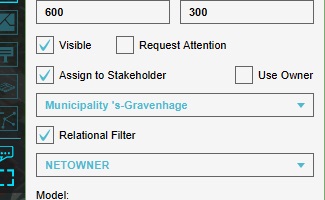
Note that for simple cases, a single stakeholder can be the net owner for all clusters in a network. However, in more complex setups it is possible to have multiple net owners. In these cases, additional panels should be created for each net owner. The configuration you just created will automatically generate their panels for all clusters under their jurisdiction.
Select "Apply Template", and the necessary instances of this panel will be created.
Note that no new popups have appeared in the 3D Visualization. For the net owner the popups are configured such that they will only appear when the net owner has a decision to make. The owner of the cluster still has to make the first connection before the popup will appear.
Switch back to the stakeholder who owns the cluster, open the popup, and click on "Connect". Then wait for the testrun to start and the connections to be made.
Switch to the network owner. Now, the connected cluster does have a popup. This is because the network owner has the ability to reject connections. Open the popup, and you will see it contains the same information the owner of the cluster has.
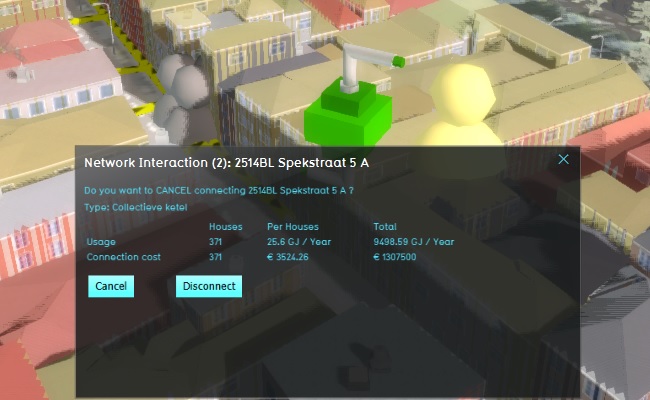
Opt to disconnect the cluster.
The net lines will disappear, because the connections will be undone, similar to when the owner of the cluster opts to disconnect. The cluster's popup for the network owner will disappear as well. The initiative to reconnect the cluster must come form the cluster owner.
Close the panel, and switch to the stakeholder who owns the cluster. Opt to reconnect the cluster, and the popup and panel will indicate the network owner must approve of the connection.
Switch to the network owner, and notice a popup is now visible, drawing attention as well.

Open the panel. It will have two explicit options to approve or deny the connection.
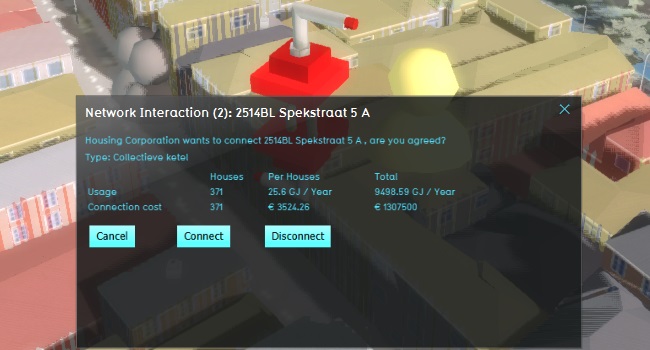
The network owner can decide, based on their own insights and dialog with the cluster's owner, whether to let the cluster be connected, or to revert it to a disconnected state. As long as the network owner does not explicitly allow the connection, the cluster will remain disconnected.
Opt to deny the connection by clicking on 'Disconnect'. Notice the cluster remains disconnected, and the popup disappears again.
As the cluster owner, opt to connect the cluster again. Now, as network owner, opt to approve the connection by clicking on 'Connect' in its popup. Notice the cluster is now connected.
Stop the testrun, so all connections are removed again.
Configure default interactions
The default process for connecting and disconnecting clusters can be tweaked.
Reopen the network wizard, and continue to the "Visualization" step.

There are two options available for tweaking the approval flow.
- Netowner approval required: Whether the network owner needs to approve any connection before a connection is made.
- Direct connect first request: If the network owner needs to approve connections, whether the first connection request is automatically approved.
By default, both options are checked, meaning that the first connection is automatically approved, but all subsequent approval requests must be approved by the network owner.
Assignments
These assignments guide some experimentation with tweaking the approval flow of networks.
- Disable the "Direct connect first request" setting, and start a testrun. Completely connect a cluster. Stop the testrun afterwards.
- Disable the "Netowner approval required" setting, and start a testrun. Connect a cluster, and note at what point the network owner is able to prevent or counter the connection of the cluster. Stop the testrun afterwards.
- In the first step of the network wizard, set the default connection status for the network to "READY". Start a testrun. Experiment with disconnecting and connecting a cluster. Stop the testrun afterwards.
- Re-enable the "Direct connect first request" and "Netowner approval required" settings. Start a testrun. Experiment with disconnecting and connecting a cluster. Stop the testrun afterwards.
Tutorial completed
Congratulations. You have now completed this tutorial. In it, you have learned how to manually and automatically create networks in your project, and interact with the network using the default interaction options.